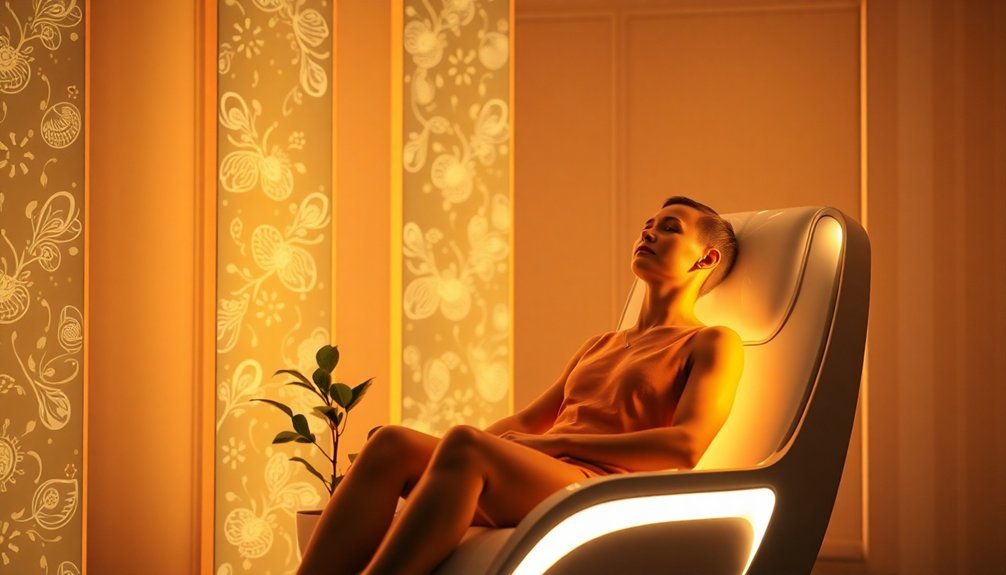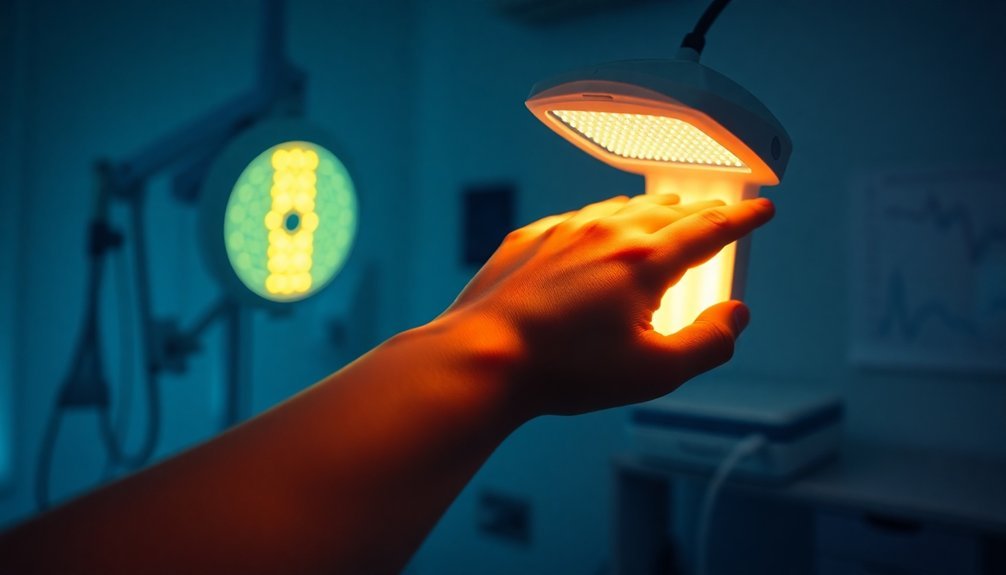Light therapy is a powerful method you can use to strengthen your blood vessels and boost heart health. By absorbing red and near-infrared light, your cells produce more energy and expand blood vessels, improving circulation. This process increases nitric oxide levels, which helps lower blood pressure and enhances nutrient delivery to your heart. Studies show that regular exposure can even reduce inflammation and oxidative stress, essential factors in heart disease. As you explore this topic further, you'll find exciting research and insights into how light therapy can greatly benefit your cardiovascular well-being.
Mechanism of Light Therapy

Light therapy operates primarily through the absorption of red and near-infrared light by your skin and tissues.
This process allows mitochondria in your cells to soak up these light particles, ramping up the production of adenosine triphosphate (ATP), which is essential for cellular energy. As ATP levels rise, your cells gain the energy they need to repair themselves and enhance various metabolic functions.
Furthermore, light therapy stimulates endothelial cells, improving their migration and proliferation.
Under this therapy, these cells elongate and interact better with each other, which promotes the release of nitric oxide. This release leads to vasodilation, ultimately improving blood flow and vascular tone. Additionally, enhanced endothelial cell activity through light therapy has been shown to have potential therapeutic applications for cardiovascular health.
Benefits on Cardiovascular Health
Therapies that harness the power of light can considerably enhance cardiovascular health, offering a range of benefits that help maintain and improve heart function.
For instance, if you're dealing with heart failure, light therapy can enhance your heart's efficiency by improving cardiac wall thickness and energy production in heart tissues. This therapy boosts ATP production in your mitochondria, making your heart less stiff and more effective at pumping blood.
You'll also experience reduced oxidative stress and inflammation, which are major risk factors for heart disease. Light therapy helps regulate immune function and reduces inflammation in heart tissues, promoting overall heart health. Additionally, boosting the PER2 gene through this therapy has been shown to provide protection against conditions like myocardial ischemia.
Moreover, by increasing nitric oxide levels, this therapy enhances vasodilation and blood flow, delivering essential nutrients and oxygen throughout your body. This improved circulation can lower blood pressure and even alleviate symptoms of peripheral artery disease, allowing for greater mobility.
Lastly, embracing light therapy may slow cardiovascular aging, delaying the onset of heart disease and improving overall heart function.
With such an array of benefits, incorporating light therapy into your routine could be a powerful tool for your cardiovascular health.
Evidence From Human Studies

When you consider light therapy protocols, it's clear that exposure duration and intensity play essential roles in its effectiveness. Studies show that participants benefit from structured sessions, with improvements in metabolic markers like plasma triglycerides. This evidence suggests that light therapy can lead to promising cardiovascular health outcomes worth exploring further. Additionally, findings indicate that 670 nm light facilitates vasodilation through the release of nitric oxide precursor, enhancing blood flow.
Light Therapy Protocols
Current research on light therapy protocols for heart health is still in its infancy, primarily relying on data from animal studies rather than direct human trials. While studies on mice suggest promise, human data is essential for validating these effects. Specifically, no direct studies on photobiomodulation (PBM) for heart health in people exist yet.
For future research, you'll need to determine the ideal light wavelength, intensity, and exposure duration for humans. Animal studies have shown success with near-infrared light at 850 nm, but human responses may differ.
A suggested dosage from animal studies includes 25 mW/cm² for 2 minutes each weekday; however, you must validate these dosages for human applications. Additionally, outcome measures in human trials should focus on heart function improvements, cardiac remodeling, and other cardiovascular markers.
Challenges like ensuring consistent exposure and addressing ethical concerns will also need attention.
As researchers plan controlled human clinical trials, the collaboration between institutions and setting clear participant selection criteria will be vital. Ultimately, these steps will allow for a thorough understanding of PBM's potential benefits in heart health.
Metabolic Improvements Observed
How can light therapy potentially revolutionize metabolic health? Recent studies show promising metabolic improvements in human subjects, making light therapy a game changer. When volunteers were exposed to 10,000 lumens of light, their PER2 levels increased. This gene plays an essential role in regulating circadian rhythms and protecting cardiovascular tissues from low oxygen conditions.
It's fascinating to see how these results align with earlier mouse studies. Additionally, intense light therapy led to notably decreased plasma triglycerides after just five days of treatment. Lower triglyceride levels indicate improved insulin sensitivity and carbohydrate metabolism, further enhancing overall metabolic health.
After only 30 minutes of exposure each day, these benefits became apparent. Light therapy also improved blood flow regulation by increasing cardiac adenosine, a key component for maintaining ideal blood flow, especially during low oxygen situations. This regulation is critical in reducing damage during heart attacks.
Comparison With Other Therapies
Light therapy offers a unique alternative to traditional treatments for heart health, especially when compared to other therapies like vascular exercises and resistance training.
While vascular exercises, which include heel raising and dorsiflexion against resistance, may considerably improve chronic venous insufficiency by enhancing lower limb function, light therapy can also promote vascular health with less invasiveness. These exercises require dedication, involving 30 minutes a day for 12 weeks, yet they yield marked improvements in pain reduction and functional ability.
On the other hand, vascular massage therapy, while beneficial for blood flow, falls short in efficacy against chronic venous insufficiency compared to the more robust results from vascular exercises.
Resistance training also offers substantial benefits, lowering blood pressure and enhancing endothelial function, but requires a commitment to regular sessions.
Conversely, light therapy stands out as a safe, effective option that not only enhances heart function in chronic heart failure but also promotes angiogenesis and reduces inflammation.
With the potential for preventive benefits against arteriosclerosis, light therapy may serve as a compelling complementary treatment alongside traditional therapies, making it a worthy consideration for heart health.
Clinical Applications and Strategies

You might want to contemplate how light therapy can be integrated into pre-surgical protection methods for patients at risk of heart complications.
This approach couldn't only enhance patient safety but also open up exciting opportunities for drug development aimed at maximizing cardiovascular benefits.
As you explore these clinical applications, the potential for innovative strategies becomes increasingly compelling.
Pre-surgical Protection Methods
In preparing for surgery, pre-surgical protection methods, including innovative approaches like preoperative light therapy, can greatly enhance patient outcomes.
By exposing you to intense light for a week before a high-risk surgery, this therapy increases cardioprotection against potential heart injuries. The mechanism behind this is fascinating: intense light amplifies the PER2 gene, which helps protect your cardiovascular tissues in low oxygen conditions, while also triggering growth factors that regulate inflammation and immune function.
You'll want to pay attention to the exposure details. Studies suggest that while the intensity of the light is essential, the duration isn't as significant. For example, just 30 minutes of intense near-infrared light (about 10,000 LUX) over five consecutive days can show significant benefits.
This method could benefit patients who've a history of heart issues or are considered high-risk.
Integrating preoperative light therapy with other strategies, like pharmacologic optimization, can further enhance your cardiac protection before surgery. The combined approach helps to guarantee that you're in the best possible condition for any surgical procedure.
Drug Development Opportunities
Innovative advancements in light therapy are paving the way for new drug development opportunities aimed at enhancing cardiovascular health. You'll find that light-regulated drugs can target essential receptors like adrenoceptors and muscarinic acetylcholine receptors, effectively controlling cardiac function. With the use of a photoswitch mechanism, these drugs allow for remote regulation of therapeutic actions.
These unique characteristics highlight several promising opportunities:
| Drug Type | Mechanism of Action | Clinical Potential |
|---|---|---|
| Light-Regulated Drugs | Target receptors to control cardiac function | Minimize unintended effects |
| Intense Light Therapy | Amplifies PER2 gene to protect tissues | Possible drug development for metabolism improvement |
| Photobiomodulation (PBM) | Activates TGF-β1 for stem cell activity | Potential improvement in heart function |
| Spatial Control Drugs | Offers remote activation | Reduces risks associated with traditional drugs |
| Gene-Mimicking Drugs | Mimics protective effects of light therapy | Enhances patient outcomes in various conditions |
As you explore these avenues, the potential for targeted therapies tailored to individual needs becomes increasingly clear. Further research and clinical studies will deepen our understanding and refine these strategies for broader applications.
Recent Research Findings
Recent findings highlight the promising potential of light therapy, particularly near-infrared light, for enhancing heart health. A study involving 14-month-old middle-aged mice showed significant improvements in heart function after exposure to near-infrared light, administered five days a week for two minutes daily.
Importantly, genetically manipulated mice with severe heart disease experienced no disease progression and achieved a 100% survival rate compared to 43% for untreated counterparts.
Photobiomodulation (PBM) therapy reduced cardiac wall thickness and stiffness while improving heart pumping action. This therapy also enhanced gait symmetry, suggesting improved neuromuscular coordination.
In pilot studies on human participants, near-infrared light therapy positively impacted heart rate, variability, and blood pressure by dilating blood vessels and improving circulation.
Results showed that repeated exposure helped those with hypertension, diabetes, and high cholesterol regain vascular endothelial function.
Despite these promising results, controlled clinical trials in humans are essential to confirm safety and efficacy. Adjusting parameters like light wavelength, intensity, and exposure time is important to guarantee therapeutic benefits without harmful effects.
Frequently Asked Questions
Is Light Therapy Safe for Everyone?
Light therapy isn't safe for everyone. If you're healthy and unmedicated, it's generally fine. However, if you have ocular issues or take certain medications, you should be cautious and consult your doctor.
How Long Should Each Light Therapy Session Be?
For light therapy sessions, start with 5-10 minutes, gradually increasing to 15-20 minutes based on your comfort and response. Aim for 3-5 sessions per week for best results, monitoring how your body reacts.
Can Light Therapy Replace Traditional Heart Medications?
You might find that light therapy shows promise as an alternative to traditional heart medications. However, it needs more research and clinical trials to confirm its effectiveness and safety before considering it a replacement.
Are There Any Side Effects of Light Therapy?
Yes, light therapy can have side effects like irritability, headaches, and sleeping issues. If you experience discomfort, adjusting your session times or seeking advice from a professional may help alleviate these concerns.
What Type of Light Is Used in Therapy?
In therapy, you'll often use intense light sources like 10,000 LUX, alongside red light wavelengths around 630 nm to 810 nm. These lights improve cellular function and enhance blood flow, benefiting overall health.
In Summary
Incorporating light therapy into your routine might just strengthen your blood vessels and improve your heart health. As research continues to support its benefits, it could be a valuable addition to traditional treatments. Whether you're looking to enhance your cardiovascular fitness or explore innovative therapies, light therapy offers promising outcomes. Always consult with a healthcare professional to determine the best approach for you, but don't overlook the potential of this exciting treatment in your health journey.





Leave a Reply